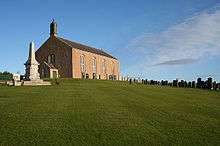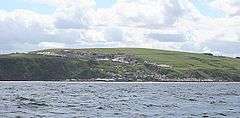Gardenstown
Coordinates: 57°39′58″N 2°19′59″W / 57.666°N 2.333°W
Gardenstown (Scots: Gamrie)[1] is a small coastal village, 8.7 miles (14.0 km) by road east of Banff in Aberdeenshire, northeastern Scotland. The village's main economic base is fishing. Gardenstown is served by Gamrie Parish Church. The hamlet of Dubford is to the south, and a footpath along the shore to the east leads to the village of Crovie.
History
There is evidence of Neolithic or Bronze Age peoples having settled in the vicinity of Gardenstown; notably at Longman Hill[2] and Cairn Lee. Nearby are the remains of the Church of St John the Evangelist which was built in 1513, and celebrates the defeat of the Danes at this site in 1004 in the 'Battle of the Bloody Pits'.[3]
Gardenstown was founded in 1720 by Alexander Garden as a fishing village. A church was built in 1875, and the parish of Gardenstown was separated from Gamrie on 16 March 1885.[4] In 1953, heavy flooding washed away two houses in the village.[5]
In May 2007, a TV series titled The Baron was filmed in and around the village. The series featured three celebrities — Malcolm McLaren, Mike Reid and Suzanne Shaw — competing to be elected "Baron of Troup". During the filming, McLaren was thrown out of the village for unruly behaviour,[6] leaving Reid and Shaw to contest the final election, which was won by Reid.
Between 2008-2010, an ethnographic study of the social, religious and economic life of the village was conducted by anthropologist Joseph Webster. This was published by Palgrave in 2013 as a book entitled The Anthropology of Protestantism: Faith and Crisis among Scottish Fishermen.[7]
In January and February 2008, the village again made headlines when Aberdeenshire Council refused funding to restore the road which runs along the seafront and is a key part of the village's sea defences. The refusal was based upon the status of the road as a private road, thus not the responsibility of the council. This has been seen as controversial since the road runs along the top of the seawall, and the council is responsible for the wall. Residents expressed grave concern that their houses might be washed away and appealed.[5]
Landmarks and local economy

The village's main economic base is fishing. A permanent meteorological station is situated at Gardenstown. The village is served by Gamrie Parish Church and has a pub, an osteopathy clinic[8] and a whale and dolphin rescue centre.[9] Until recently there was a bakery and a butcher's shop.
Notable people
- Joseph Watt, recipient of the Victoria Cross
See also
References
- ↑ "Gamrie". The Online Scots Dictionary. Retrieved 5 July 2014.
- ↑ Hogan, C. Michael (2008). "Longman Hill". Modern Antiquarian. Retrieved 5 July 2014.
- ↑ "The Battle of "the Bloody Pits". Discovergardenstown.co.uk. Retrieved 5 July 2014.
- ↑ Scott, Hew; Macdonald, Donald Farquhar (1926). Fasti Ecclesiæ Scoticanæ: The Succession of Ministers in the Church of Scotland from the Reformation. Oliver and Boyd. p. 261.
- 1 2 "Fears for seaside village homes". BBC News Scotland. Retrieved 5 July 2014.
- ↑ "The Scotsman: Anarchy in Gardenstown". The Scotsman. Retrieved 5 July 2014.
- ↑ Webster, Joseph (19 June 2013). The Anthropology of Protestantism: Faith and Crisis Among Scottish Fishermen. Palgrave Macmillan. ISBN 978-1-137-33654-5.
- ↑ "Gamrie Osteopathy Clinic". Gamrieosteopath.co.uk. Retrieved 2 May 2015.
- ↑ "Garden Arms". Gardenarms.co.uk. Retrieved 5 July 2014.
External links
| Wikimedia Commons has media related to Gardenstown. |
- The local tourist board
- Gardenstown webcam and local pictures
- Cetacean Research & Rescue Unit
- Garden Arms Hotel
- Gamrie Osteopathy Clinic
- Gardenstown weather station
- Pictures of Gardenstown



